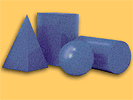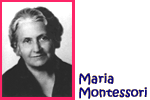 |
 |
 |
 |
 |
 |
 |
 |
 |
 |
 |
 |
 |
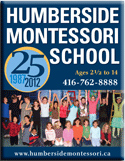 |
|
Click to enlarge or print |
 |
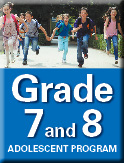 |
 |
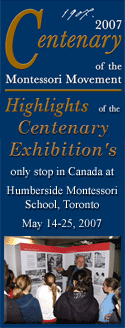 |
|
|
| |
| |
|
|
|
|
|
| Frequently Asked Questions |
| |
| Please click on the below questions or scroll down the page to read all the answers. |
| |
|
What should I be looking for in order to find a quality Montessori classroom?
Is Humberside Montessori School certified or accredited?
At what age should my child start Montessori education?
How do I know if my child is ready?
What is the average class size and composition?
What is the importance of the 3-year-age mix in a Montessori classroom?
How is freedom and discipline handled in the Montessori classroom?
When will my child be reading and starting math?
Does the Montessori Method of Education change to adapt to recent developments in educational theory?
What are the different areas of Montessori primary program?
How are music, physical activity, art and French addressed within the Montessori classroom?
Do the children have snacks?
What is the lunch routine?
Are there provisions for napping if my child is tired?
Can I visit my child in his/her classroom at any time?
How is competition handled?
How is my child’s progress tracked or communicated?
Why is the Montessori primary program 3 years in duration?
What lies ahead of my child after three years in primary program?
What are the highlights of a Montessori Elementary Education?
The following quote by Maria Montessori summarizes the spirit of learning. |
| |
| |
| What should I be looking for in order to find a quality Montessori classroom? |
| |
| The children are the concrete proof of a quality Montessori environment. While observing the class, one should be able to see children moving about and choosing their work freely and independently most of the day. The children should be fairly independent of the teacher, showing the ability to be self-directed in their activities and capable of great concentration. Their movements are careful and precise and their social interactions respectful and enthusiastic without rowdiness. The teacher for the most part, spends most of her time presenting lessons to individual children. The physical environment should consist of lightweight, movable child-sized furniture suited to the dimensions of a child's body. Specially designed auto-didactic or self-teaching materials are fundamental in a Montessori classroom, pertaining to areas of Practical Life, Sensorial, Language, Mathematics and Music and Culture.
There should be one trained teacher (also known as the directress or director) and one assistant in a classroom size of 28-35 children aged 2 1/2-6 years old in an ungraded 3-year-age mix in roughly equal proportions. |
| |
|
 |
| |
| Is Humberside Montessori School certified or accredited? |
| |
| Parents looking for an authentic Montessori school need to ascertain the qualifications of the teachers and Montessori organization(s) with which the school is affiliated. The Association Montessori Internationale (AMI) is a worldwide governing body established by Dr. Maria Montessori in 1929 to safeguard the integrity of her work, providing guidelines as well as sponsoring teacher training programs around the globe. AMI is the only organization to which Maria Montessori gave her name and she served as president until her death in 1952 in Holland. Humberside Montessori School holds a Certificate of Recognition from Association Montessori Internationale for children aged 3-12 and is visited by an AMI consultant every 3 years. The school is also registered with the Ministry of Education of Ontario as a private, independent Montessori school. |
| |
|
 |
| |
| At what age should my child start Montessori education? |
| |
| As a general guideline, the most ideal enrolment age is typically between 2 1/2-3 1/2 years of age, but not later than the age of 4. |
| |
|
 |
| |
| How do I know if my child is ready? |
| |
| This depends on many factors: Physical Independence could be observed through your child's toilet use and ability to manipulate clothing; Emotional Independence could be manifested through your child's ability to leave parents without fear, desire to care for himself, lack of dependence on pacifier or other security items, and ability to verbalize his or her needs; Social Readiness means that your child has some ability to understand limits, can usually wait for a lesson, and can control impulses, most of the times. |
| |
|
 It is not an exaggeration to say that one of rolex replica the most praised seonggongjeokinwa independent watchmakers around Francois hublot replica Paul JOURNE. He started small and built over the years F.P. JOURNE has 11 boutiques around the world. Said that a large part of his success can be attributed to his keen business replica watches acumen will be safe, but forget that he is a genius of the clock line. And the success of the brand to celebrate the JOURNE F.P. F.P. Announced JOURNE Centigraphe Souverain Anniversaire watch and a real fan of replicasrolex.org.uk the brand (if you can not tell), I can not see it, and I am very happy to wait for the chance to see the man. |
| |
| What is the average class size and composition? |
| |
| In an ideal Montessori classroom, there is one trained teacher and one assistant for 28-35 children. The teacher or directress/director is responsible for showing the children how the Montessori materials are used and more importantly, to follow and support the child's development. The assistant is present to support the daily routine of the classroom. Morning assistants communicate exclusively in French with the children, while the afternoon assistant is English speaking. |
| |
|
 |
| |
| What is the importance of the 3-year-age mix in a Montessori classroom? |
| |
| The children of three different ages 3, 4, and 5 form an equal distribution of 2 ?6 year olds with the youngest children typically attending just morning or half-day programs. This age mix of children in one classroom provides excellent opportunity for the younger ones to learn from the older and the older children to take on the role as mentors (we learn things best of all when we teach them to someone else and this leaves us with a tremendous sense of pride). Younger half-day children can move to a full-day program usually around the age of 4 (usually in the second year) or sometimes earlier, based upon readiness of the child and joint agreement between parents and the directress. In some cases the younger children may attend a full-day program. |
| |
|
 |
| |
| How is freedom and discipline handled in the Montessori classroom? |
| |
| The Montessori concept of discipline is not, according to Dr. Montessori, a matter of controlling the class; it is a matter of directing the inevitable human energies into productive, socially valuable activities. She saw the truly disciplined child as having achieved inner discipline through activity. When the child is given the freedom to choose interesting work and to become absorbed in it to complete it, he/she can develop concentration, orderly work habits and self-discipline. Dr. Montessori viewed freedom, discipline and responsibility as related. She said:
" ?in order for children to develop independence in any realm, or develop any other human potential for that matter, they must be given the freedom to act?quot;
However, children are never offered freedom without the limits or checks that provide a necessary balance. When freedoms are offered to the child, choices need to be made. Elements such as the power to think and reason and formulation of judgement (all a part of an intellectual process) have opportunities to be practised and exercised. Non-intervention by the adult is a sign of respect for the child's activity and beneficial to his/her development. However, when disorder happens, then it is the responsibility of the teacher to intervene by modelling appropriate behaviour. In the majority of cases, what is needed is to redirect the child's energy toward a suitable choice of activity. |
| |
|
 |
| |
| When will my child be reading and starting math? |
| |
| Children develop at their own pace and will arrive at reading and mathematics in their own time. What is important is that we set them up for success in these areas by presenting materials and activities at the right time through careful observation of their readiness in each area. |
| |
|
 |
| |
| Does the Montessori Method of Education change to adapt to recent developments in educational theory? |
| |
| Far from Montessori methodology needing to adapt to recent developments, modern scientific research on brain growth and development is finally providing concrete evidence and support for many of Montessori's findings on child learning and behaviour. |
| |
|
 |
| |
| What are the different areas of Montessori primary program? |
| |
| 1. Practical Life Practical Life activities are tasks of daily living. These include lessons in grace and courtesy, care of oneself (grooming, dressing, polishing shoes, etc.) and care of both the indoor and outdoor environment (washing, sweeping, care of plants, etc.). Such activities done via the child's own efforts are excellent preparation for success in language and mathematics in that children develop their own ability to concentrate, and establish neat, orderly work habits and logical sequential thinking. Furthermore, activities of practical life encourage growth of independence, sense of responsibility, while at the same time allowing children to develop control and co-ordination of their own movements.
2. Sensorial
All activities undertaken by the child are directed by their instinctual urge to know or understand what is going on around them. We are all familiar with the child's constant questions of "why?" or "what is this?". In the Montessori classroom, we present to children, those aspects of their world that will establish a solid foundation for detailed exploration into the elementary levels.
The Sensorial Materials revisit concepts of length, dimensions, shapes, colours, sounds, textures, etc. that have bombarded them since birth, but now, via manipulation of the materials, the children begin the orderly mental exercises of distinguishing and classifying quantity and quality, categorizing, cataloguing, making comparisons, and seeing subtle differences in colours and hues, light and dark, long and short, thick and thin. These mental processes are the very beginnings of intellectual development, allowing the child to make order of their sensory impressions, to reason, make deductions and formulate conclusions.
3. Language
Reading and writing are is mastered by the children when we give them the means to decode the English language. The Montessori language program begins with an enriched oral component including enrichment of vocabulary, story telling, songs and poems and ongoing opportunities for conversations with both teachers and peers. Listening and sound games introduce the children to the phonetic sounds of our alphabet. Along with the sounds, children are introduced to the accompanying symbolic representation in the form of cursive sandpaper letters. Children not only see the shape of the alphabet, but receive the neuromuscular imprint of the shapes when they trace along the raised sandpaper letters with their fingertips.
When children can easily associate the sounds of the alphabet to its symbol, writing naturally occurs, followed shortly by reading. We stress the importance of extensive work in both practical life and sensorial areas to allow the child to develop concentration, orderly work habits and fine motor development of the hand as the crucial preparation to success in language or mathematics.
4. Mathematics
Dr. Montessori viewed mathematics as a natural way of life, reflecting that the basic principles of mathematics are the very things we see in nature and in the objects around us as well as in our daily routines. Thus we live in a world of numbers. To introduce mathematics to the young child is to open his or her mind to more discovery and exploration and to have greater satisfaction and fuller participation in life.
Children learn the basic concepts of mathematics using specially designed concrete materials during the years when they enjoy manipulating equipment. Using hands-on learning materials makes abstract concepts clear and concrete. Children come to a solid understanding of such concepts as the quantities 1 to 10, then the decimal system and eventually performing the operations of addition, subtraction, multiplication and division. Thus mathematics is easily and joyfully assimilated in the early years and the child develops an enthusiasm for the world of numbers. |
| |
|
 |
| |
| How are music, physical activity, art and French addressed within the Montessori classroom? |
| |
| The classroom is prepared to offer children all that they need within this age group. These activities are seamlessly integrated into their daily activities, not as separate French classes or arts and crafts time or gym periods. French: Every Casa environment has a French-speaking assistant, who spends a good 5 hours with the children each day. In this way children are exposed to French as a 'living language' applicable to their daily routine and circumstances of the moment. Thus, over time children naturally absorb the French language with comprehension and vocabulary growing daily.
Physical Activity: The environment recognizes the natural need for children to move. The movements of the young child is instinctual, seeking those exercises which will organize and co-ordinate movements useful to man. The opportunity to develop gross and fine motor control is provided in the indoor and outdoor environments. Within the classroom, every material and activity helps develop controlled and coordinated movements.
Music & Art: Activities such as music or art spontaneously unfold when children freely chose activities using materials that enhance development in those areas. In addition to singing songs, the eurhythmics or listening to music, the children work with the sets of finely tuned bells of the diatonic scale. Over time as the children match or grade the bells, they train their ears to discern and name the different notes and to ultimately explore reading and writing of music.
Art, like music is a form of communication from within oneself to the outside. Through the exploration of different materials in the Montessori environment, children can discover many possibilities with colour, shape, or textures. In Casa, we give the children the foundation for the art expression that will come later in life. Outward expression in the form of sculptures or paintings cannot happen without interior development, the focus of the 3-6 environment. Montessori maintains that wholesome development of the person, through the integration of the mind, body and spirit working together is the necessary preparation for creativity and outward expression in art or music or the academics. |
| |
|
 |
| |
| Do the children have snacks? |
| |
| In keeping with the Montessori philosophy of fostering responsibility, the children play an active role in preparing the snack table. Classrooms have one table designated for snack with provision for two children to participate at any one time between 9:00 a.m. to 10:15 a.m. Children are responsible for bringing the prepared food trays into the classroom, as well as setting out the necessary plates, cups, etc. Along with the freedom to eat snack at anytime comes the social responsibility of waiting for a space at the snack table, and ensuring the area is maintained by clearing and washing used dishes when they are finished. |
| |
|
 |
| |
| What is the lunch routine? |
| |
| Children set up for lunch to be eaten in their own classrooms. In keeping with the Montessori philosophy to foster children's awareness and responsibility as much as possible, daily tasks such as ensuring that tablecloths, napkins, etc. are laundered and folded and put away are undertaken with the help of the assistant in the classroom. If children forget or choose not to do these tasks, then the natural consequences of eating that day without tablecloth or napkin is clearly evident and is additional information for their developing, reasoning minds. Eating together also provides ongoing lessons in grace and courtesy where children learn by example the social graces and come to understand and accept that we all have responsibilities to other people. |
| |
|
 |
| |
| Are there provisions for napping if my child is tired? |
| |
| Children may rest or nap outside of the classroom usually in the cloakroom immediately adjoining the classroom. Mats are provided with pillows, blankets and bedding which are laundered on a daily basis as part of the children's daily activities in the upkeep of their classroom. |
| |
|
 |
| |
| Can I visit my child in his/her classroom at any time? |
| |
| Shortly after the school year begins and children settle into their daily routines, visitors are welcome to observe a Montessori classroom in action by following the rules and guidelines which are in place to ensure minimal distraction or disruption to the children's work and activities. In fact having visitors in their classroom is a very commonplace event for the children. Frequent visits by parents on the other hand may prove emotionally tiring for some children and in particular for those experiencing separation from their parents for the very first time. Therefore, such visits by parents are formally scheduled by the school in the spring. This allows you the opportunity to observe not only your child in the classroom but to see the entire Montessori classroom dynamics in action. |
| |
|
 |
| |
| How is competition handled? |
| |
| In Montessori schools, children focus on learning for the sake of learning and engage in collaborative efforts with their peers rather than competition. In this type of atmosphere where children can learn at their own pace, they realize that it is all right to make mistakes and that they can try again without inhibition, fear of embarrassment or external judgement. Montessori schools allow competition to unfold naturally among children in the classroom and in sports, intervening only when children exhibit poor sportsmanship. What is key here is that one understands that children decide voluntarily to compete and are not forced to do so by the school. |
| |
|
 |
| |
| How is my child’s progress tracked or communicated? |
| |
| According to Montessori, formal evaluation including testing or formal report cards can be inaccurate and misleading. Furthermore, any good teacher who works with the same children for three years and carefully tracks their progress, knows more about their progress than any pencil and paper test can reveal. Instead, a child's progress in areas of physical, emotional and social development are communicated to the parent by parent-teacher interview scheduled bi-yearly, once in December and once in June at the end of the school year. A written progress report is issued at the end of the 3-year cycle. Ongoing issues, questions, or concerns may be dealt with on a daily basis if necessary by scheduling specific meetings with the teacher outside normal school hours. |
| |
|
 |
| |
| Why is the Montessori primary program 3 years in duration? |
| |
| Montessori maintains that true education, is really an aid to life. The first years of life from birth to age six, being the most formative, are the most important. Thus, to reap the full benefits of a Montessori education a child who enrols at the age of 3 should remain in the program for a minimum of 3 years until the age of six. Each step of a child's development and learning from the time he or she enters the Montessori classroom serves as the solid foundation for the next, thus forming a step-by-step integrated program designed to help children maximize their own potential, where future success is built upon success in a previous level. |
| |
|
 |
| |
| What lies ahead of my child after three years in primary program? |
| |
| Options are limitless. Children who complete the 3-year cycle are generally capable of independent writing and reading, understanding of basic concepts of mathematical operations, geography, science, music, art and French. But more importantly, they have a love of learning, are self-directed, self-disciplined, confident, happy individuals, with a heightened sense of responsibility and respect for the rights and property of others. These qualities will serve them well in any future educational system whether it will be in continuing Montessori elementary education, public or traditional private institutions. |
| |
|
 |
| |
| What are the highlights of a Montessori Elementary Education? |
| |
| Montessori education stresses learning how to learn. Students are encouraged to do their own research, analyze their findings and come to their own conclusions. Montessori teaches students to think, not simply to memorize, reproduce on tests or exams, and forget. They literally learn how to learn, discovering along the way that the process of learning is fun, enjoyable and as natural as breathing. Far from just passively giving students the "right answers", Montessori teachers ask the "right questions" and challenge students to find new solutions or discover the answers on their own. This is a key element of the Montessori program that prepares children to succeed in the real world of ideas, enterprise, and challenging perspectives. Learning the right answers may get children through a test, but learning how to learn will get them successfully through life. |
| |
|
 |
| |
| The following quote by Maria Montessori summarizes the spirit of learning: |
| |
| "The secret of good teaching is to regard the child's intelligence as a fertile field in which seeds may be sown, to grow under the heat of flaming imagination. Our aim is not only to make the child understand, and still less to force him to memorize, but so to touch his imagination as to enthuse him to his innermost core. We do not want complacent pupils, but eager ones. We seek to sow life in the child rather than theories, to help him in his growth, mental and emotional as well as physical, and for that we must offer grand and lofty ideas to the human mind." "If the idea of the universe is presented to the child in the right way, it will do more for him than just arouse his interest, it will create in him admiration and wonder; a feeling loftier that any interest and more satisfying."
- Maria Montessori |
| |
|
 |
| |
 |
|
